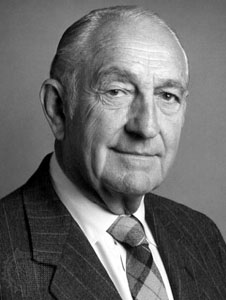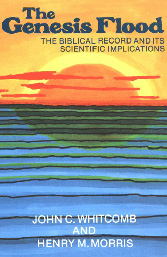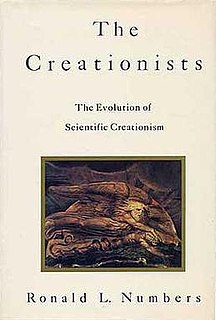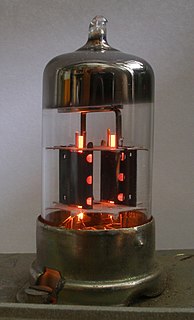
Acoustics is the branch of physics that deals with the study of all mechanical waves in gases, liquids, and solids including topics such as vibration, sound, ultrasound and infrasound. A scientist who works in the field of acoustics is an acoustician while someone working in the field of acoustics technology may be called an acoustical engineer. The application of acoustics is present in almost all aspects of modern society with the most obvious being the audio and noise control industries.

Jean Louis Rodolphe Agassiz was a Swiss-American biologist and geologist recognized as an innovative and prodigious scholar of Earth's natural history. Agassiz grew up in Switzerland. He received Doctor of Philosophy and medical degrees at Erlangen and Munich, respectively. After studying with Cuvier and Humboldt in Paris, Agassiz was appointed professor of natural history at the University of Neuchâtel. He emigrated to the United States in 1847 after visiting Harvard University. He went on to become professor of zoology and geology at Harvard, to head its Lawrence Scientific School, and to found its Museum of Comparative Zoology.

David Packard was an American electrical engineer and co-founder, with William Hewlett, of Hewlett-Packard (1939), serving as president (1947–64), CEO (1964–68), and Chairman of the Board of HP. He served as U.S. Deputy Secretary of Defense from 1969 to 1971 during the Nixon administration. Packard served as President of the Uniformed Services University of the Health Sciences (USU) from 1976 to 1981. He was also chairman of the Board of Regents from 1973 to 1982. Packard was the recipient of the Presidential Medal of Freedom in 1988 and is noted for many technological innovations and philanthropic endeavors.

Old Earth creationism is a form of creationism which includes gap creationism, progressive creationism, and theistic evolution. Old Earth creationism is typically more compatible with mainstream scientific thought on the issues of physics, chemistry, geology, and the age of the Earth, in contrast to young Earth creationism.

William "Velvel" Morton Kahan is a Canadian mathematician and computer scientist who received the Turing Award in 1989 for "his fundamental contributions to numerical analysis" , was named an ACM Fellow in 1994, and inducted into the National Academy of Engineering in 2005.

Flood geology is the attempt to interpret and reconcile geological features of the Earth in accordance with a literal belief in the global flood described in Genesis 6–8. In the early 19th century, diluvial geologists hypothesized that specific surface features were evidence of a worldwide flood which had followed earlier geological eras; after further investigation they agreed that these features resulted from local floods or glaciers. In the 20th century, young Earth creationists revived flood geology as an overarching concept in their opposition to evolution, assuming a recent six-day Creation and cataclysmic geological changes during the Biblical Deluge, and incorporating creationist explanations of the sequence of rock strata.

Progressive creationism is the religious belief that God created new forms of life gradually over a period of hundreds of millions of years. As a form of old Earth creationism, it accepts mainstream geological and cosmological estimates for the age of the Earth, some tenets of biology such as microevolution as well as archaeology to make its case. In this view creation occurred in rapid bursts in which all "kinds" of plants and animals appear in stages lasting millions of years. The bursts are followed by periods of stasis or equilibrium to accommodate new arrivals. These bursts represent instances of God creating new types of organisms by divine intervention. As viewed from the archaeological record, progressive creationism holds that "species do not gradually appear by the steady transformation of its ancestors; [but] appear all at once and "fully formed."

The history of creationism relates to the history of thought based on the premise that the natural universe had a beginning, and came into being supernaturally. The term creationism in its broad sense covers a wide range of views and interpretations, and was not in common use before the late 19th century. Throughout recorded history, many people have viewed the universe as a created entity. Many ancient historical accounts from around the world refer to or imply a creation of the earth and universe. Although specific historical understandings of creationism have used varying degrees of empirical, spiritual and/or philosophical investigations, they are all based on the view that the universe was created. The Genesis creation narrative has provided a basic framework for Jewish and Christian epistemological understandings of how the universe came into being – through the divine intervention of the god, Yahweh. Historically, literal interpretations of this narrative were more dominant than allegorical ones.

A degree, usually denoted by °, is a measurement of a plane angle, defined so that a full rotation is 360 degrees.

The Genesis Flood: The Biblical Record and its Scientific Implications is a 1961 book by young Earth creationists John C. Whitcomb and Henry M. Morris that, according to Ronald Numbers, elevated young Earth creationism "to a position of fundamentalist orthodoxy."
Peter Stoner was Chairman of the Departments of Mathematics and Astronomy at Pasadena City College until 1953; Chairman of the science division, Westmont College, 1953–57; Professor Emeritus of Science, Westmont College; Professor Emeritus of Mathematics and Astronomy, Pasadena City College.
John Clement Whitcomb, Jr. is an American theologian and young Earth creationist. He is well known as the co-author with Henry M. Morris of The Genesis Flood, which influenced many conservative American Christians to adopt flood geology.
Bernard L. Ramm was a Baptist theologian and apologist within the broad Evangelical tradition. He wrote prolifically on topics concerned with biblical hermeneutics, religion and science, Christology, and apologetics. The hermenuetical principles presented in his 1956 book Protestant Biblical Interpretation influenced a wide spectrum of Baptist theologians. During the 1970s he was widely regarded as a leading evangelical theologian as well known as Carl F.H. Henry. His equally celebrated and criticized 1954 book The Christian View of Science and Scripture was the theme of a 1979 issue of the Journal of the American Scientific Affiliation, while a 1990 issue of Baylor University's Perspectives in Religious Studies was devoted to Ramm's views on theology.
John Laurence Kulp was a 20th-century geochemist. He led major studies on the effects of nuclear fallout and acid rain. He was a prominent advocate in American Scientific Affiliation circles in favor of an Old Earth and against the pseudoscience of flood geology. Kulp died on September 25, 2006 at the age of 85.

The Creationists: From Scientific Creationism to Intelligent Design is a history of the origins of anti-evolutionism by Ronald Numbers. First published in 1992 as The Creationists: The Evolution of Scientific Creationism, a revised and expanded edition was published under the current title in 2006.
Richard H. Bube was an American scientist.

The Hewlett-Packard Company or Hewlett-Packard was an American multinational information technology company headquartered in Palo Alto, California. It developed and provided a wide variety of hardware components as well as software and related services to consumers, small- and medium-sized businesses (SMBs) and large enterprises, including customers in the government, health and education sectors.

Perspectives on Science and Christian Faith, subtitled Journal of the American Scientific Affiliation, is the academic publication of the American Scientific Affiliation.
Russell L. Mixter was an American scientist, noted for leading the American Scientific Affiliation (ASA) away from anti-evolutionism, and for his advocacy of progressive creationism.

















